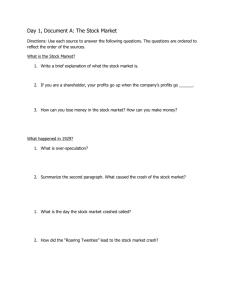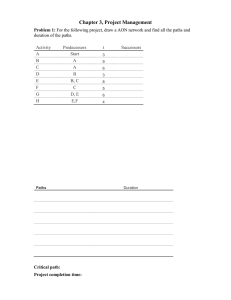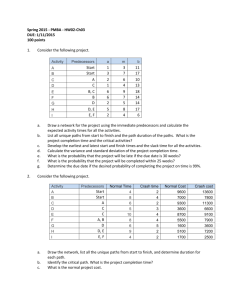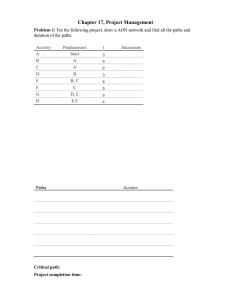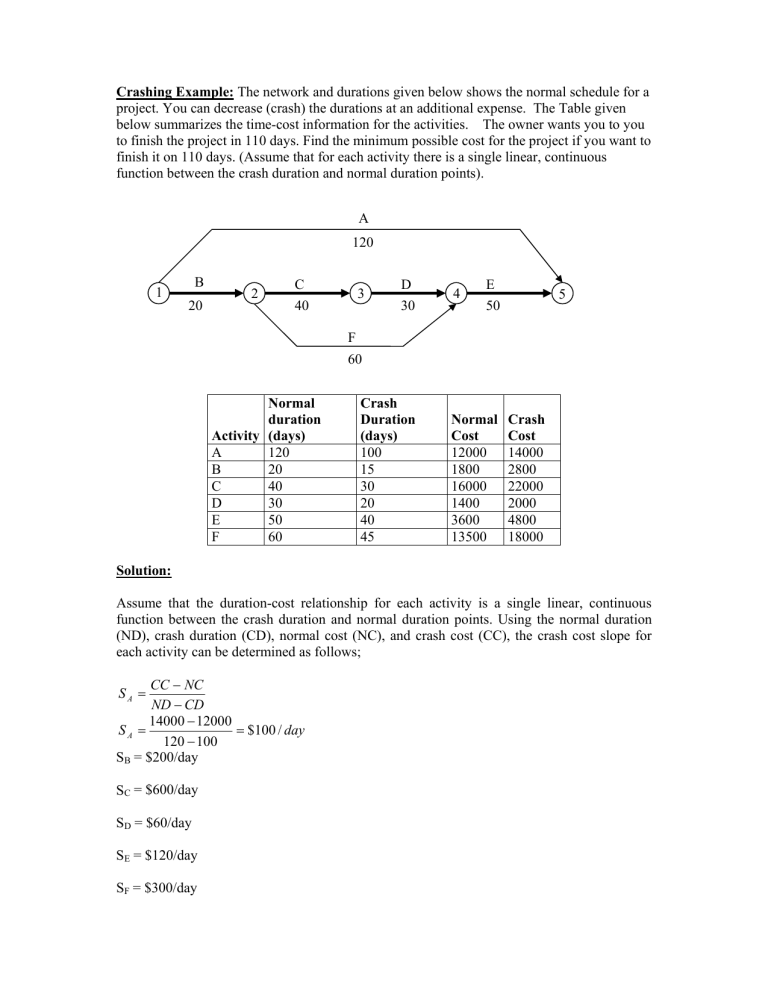
Crashing Example: The network and durations given below shows the normal schedule for a project. You can decrease (crash) the durations at an additional expense. The Table given below summarizes the time-cost information for the activities. The owner wants you to you to finish the project in 110 days. Find the minimum possible cost for the project if you want to finish it on 110 days. (Assume that for each activity there is a single linear, continuous function between the crash duration and normal duration points). A 120 B 1 20 2 C 3 40 D 30 4 E 5 50 F 60 Normal duration Activity (days) A 120 B 20 C 40 D 30 E 50 F 60 Crash Duration (days) 100 15 30 20 40 45 Normal Cost 12000 1800 16000 1400 3600 13500 Crash Cost 14000 2800 22000 2000 4800 18000 Solution: Assume that the duration-cost relationship for each activity is a single linear, continuous function between the crash duration and normal duration points. Using the normal duration (ND), crash duration (CD), normal cost (NC), and crash cost (CC), the crash cost slope for each activity can be determined as follows; CC − NC ND − CD 14000 − 12000 SA = = $100 / day 120 − 100 SB = $200/day SA = SC = $600/day SD = $60/day SE = $120/day SF = $300/day The normal cost for the project is the sum of a normal cost for each activity. The normal cost for the project is $48300 and the normal duration is 140 days. The activity which should be crashed is the one on the critical path which will add the least amount to the overall project cost. This will be the activity with the flattest or least-cost slope. The duration can be reduced as long as the critical path is not changed or a new critical path is created. In addition, the activity duration cannot be less than the crash duration. SD = $60/day (least-cost slope) Maximum of 10 days can be cut from this schedule by reducing the duration of activity D to the crash duration of 20 days. A 120 1 B 2 20 C 3 40 D 30 20 4 E 50 5 F 60 Overall duration is 130 days and there are multiple critical paths (B-F-E and B-C-D-E). Total project cost at this duration is the normal cost of $48300 plus the cost of crashing the activity D by 10 days (60 * 10 = $600) for a total of $48900. The next activity to be crashed would be the activity E, since it has the least-cost slope ($120 per day) of any of the activities on the critical path. Activity E can be crashed by a total of 10 days. Crashing the activity E by 10 days will cost an additional $120 per day or $1200. A 120 1 B 20 2 C 3 40 D 30 20 4 E 50 40 5 F 60 The project duration is now 120 days and the total project cost is $50100. There are now three critical paths (A, B-C-D-E, and B-F-E). The next stage of crashing requires a more through analysis since it is impossible to crash one activity alone and achieve a reduction in the overall project duration. Activity A is paired with each of the other activities to determine which has the least overall cost slope for those activities which have remaining days to be crashed. Activity A ($100) + activity B ($200) Activity A ($100) + activity C ($600) + activity F ($300) The least-cost slope will be activity A + activity B for a cost increase of $300 per day. Reducing the project duration by 5 days will add 5*300 = $1500 dollar crashing cost and the total project cost would be $51600. Activity B can not be crashed any more. A 120 115 1 B 20 15 2 C 3 40 D 30 20 4 E 50 40 5 F 60 Final step in crashing the project to 110 days would be accomplished by reducing the duration of activity A by 5 days to 110 days, reducing activity C by 5 days to 35 days, and reducing activity F by 5 days to 55 days. The combined cost slope for the simultaneous reduction of activity A, activity C, and activity F would be $1000 per day. For 5 days of reduction this would be an additional $5000 in total project cost. The total project cost for the crashed schedule to 110 days of duration would be $56600. A 1 B 20 15 120 115 110 2 C 3 40 35 F 60 55 D 30 20 4 E 50 40 5
